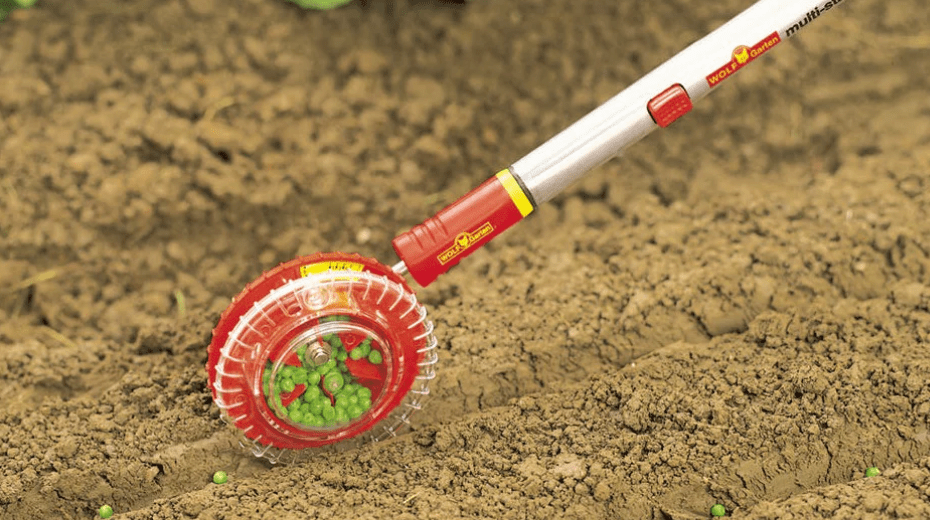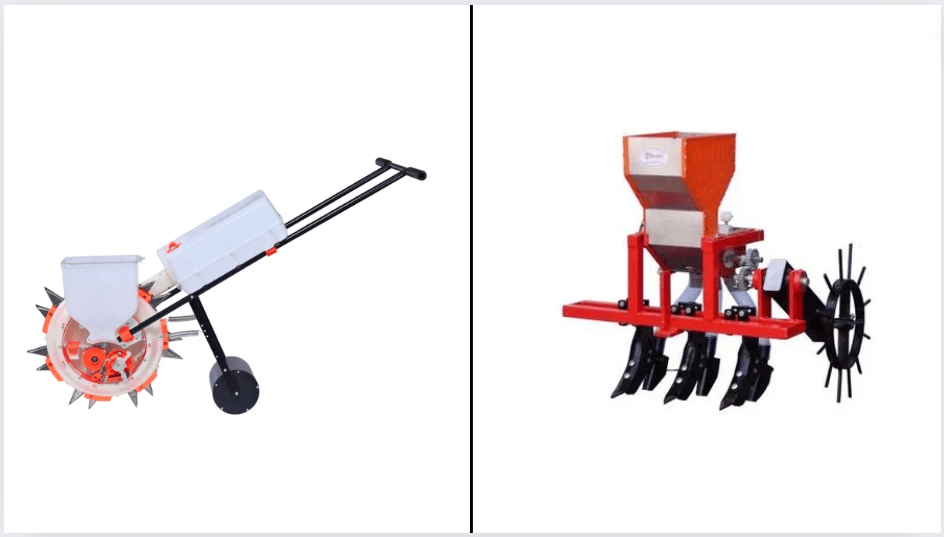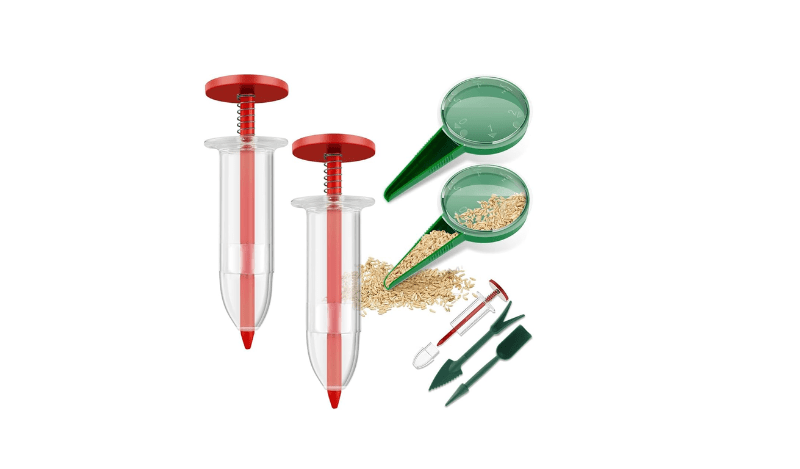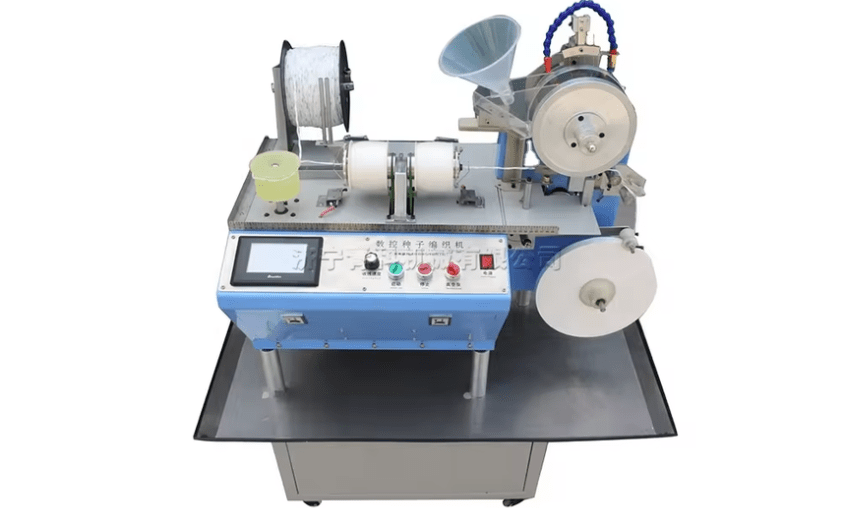
The Ultimate Guide to Garden Seed Planters: How to Choose the Right One and Get the Best Results
Garden seed planters revolutionize the way we cultivate our green spaces, making the process efficient and precise. Whether you’re a seasoned gardener or just starting out, understanding the benefits of garden seed planters is crucial for successful gardening endeavors.
Garden Seed Planters: What Are They?
Garden seed planters are specialized tools designed to simplify the process of sowing seeds in the soil. These innovative devices come in various forms, from manual handheld seed planters to mechanized seed drills, catering to the diverse needs of gardeners
Table of Contents
ToggleUnderstanding Garden Seed Planters
A. Definition and function of garden seed planters
Garden seed planters are essential tools for efficient and accurate planting of seeds in the garden. These devices are designed to create evenly spaced holes in the soil and deposit seeds at a consistent depth, making the planting process much faster and more precise than doing it by hand. There are several different types of garden seed planters available, including handheld seed planters, push seed planters, and automatic seed planters that attach to garden tractors or other machinery. Each type has its own advantages and considerations, so it’s important to choose the right one for your specific gardening needs. By using a garden seed planter, you can save time and effort while achieving more consistent and successful seed planting results in your garden.
B. Types of seed planters:

1. Manual seed planter
are the simplest and most affordable option for small-scale gardeners. These handheld devices require the user to push or press the planter into the soil to create a hole, which is then filled with a seed. Some manual seed planters also come with a built-in dibble or marker to ensure consistent seed depth. While manual seed planters are effective for small gardens, they can be labor-intensive for larger areas.
2. Push seed planters
Push seed planters are larger and more efficient than manual seed planters. They are designed to be pushed or dragged along the soil, creating multiple planting holes at once. Some push seed planters also come with seed plates that can be customized to accommodate different seed sizes and spacing requirements. These planters are ideal for larger gardens and can help to reduce planting time and fatigue.
3. Automatic seed planters
Automatic seed planters are the most advanced and expensive option, typically designed to be attached to a garden tractor or other machinery. These planters use mechanical or pneumatic systems to create planting holes and deposit seeds at a consistent rate. Automatic seed planters are ideal for commercial growers or large-scale gardening operations, as they can significantly increase planting efficiency and productivity.
When choosing a garden seed planter, consider the size of your garden, the types of seeds you will be planting, and your budget. It’s also important to consider the ease of use and maintenance requirements for each type of planter. With the right seed planter, you can streamline your gardening process and achieve more successful and consistent planting results.
Factors to Consider When Choosing a Seed Planter
A. Garden size and scale
Garden size and scale are important factors to consider when choosing a seed planter. If you have a small backyard garden, a manual or handheld seed planter may be the best option for you. These planters are easy to use and require minimal maintenance, making them perfect for small-scale gardening. On the other hand, if you have a larger garden or farm, an automatic seed planter may be more suitable. These planters are designed to handle larger areas and can significantly increase planting efficiency.
When choosing a seed planter, it’s also important to consider the types of seeds you will be planting. Some planters are designed for specific types of seeds, so make sure to choose a planter that is compatible with the seeds you will be using. Additionally, consider your budget and the ease of use and maintenance requirements for each type of planter. By taking these factors into account, you can choose the right seed planter for your gardening needs and achieve successful and consistent planting results.
B. Types of seeds to be planted
There are various types of garden seed planters available, each designed for different types of seeds and different garden sizes. For smaller gardens or personal use, a handheld seed planter may be suitable. These are easy to use and great for planting small areas. On the other hand, if you have a larger garden or farm, an automatic seed planter may be more suitable. These planters are designed to handle larger areas and can significantly increase planting efficiency. When choosing a seed planter, it’s also important to consider the types of seeds you will be planting. Some planters are designed for specific types of seeds, so make sure to choose a planter that is compatible with the seeds you will be using. Additionally, consider your budget and the ease of use and maintenance requirements for each type of planter. By taking these factors into account, you can choose the right seed planter for your gardening needs and achieve successful and consistent planting results.
C. Soil and environmental conditions
Soil and environmental conditions play a crucial role in determining the type of seed planter suitable for your gardening needs. If you have a small garden with limited space, a handheld or manual seed planter may be the best option for you. These planters are easy to use and are well-suited for smaller areas. They are also more affordable and require less maintenance. On the other hand, if you have a larger garden or farm, an automatic seed planter may be more suitable. These planters are designed to handle larger areas and can significantly increase planting efficiency. When choosing a seed planter, it’s also important to consider the types of seeds you will be planting. Some planters are designed for specific types of seeds, so make sure to choose a planter that is compatible with the seeds you will be using. Additionally, consider your budget and the ease of use and maintenance requirements for each type of planter. By taking these factors into account, you can choose the right seed planter for your gardening needs and achieve successful and consistent planting results
Manual Seed Planters
A. Pros and cons of using manual seed planters
Manual seed planters have their advantages and disadvantages. One of the main benefits of using a manual seed planter is that they are much more affordable compared to automatic seed planters. They also require less maintenance, which can save you time and money in the long run. Manual seed planters are also suitable for smaller gardens or plots of land, making them a practical choice for hobby gardeners or small-scale farmers.
However, manual seed planters can be more labor-intensive and may not be suitable for larger areas. They require the user to manually operate the planter, which can be tiring and time-consuming for larger gardening projects. Additionally, manual seed planters may not offer the same level of precision and efficiency as automatic seed planters, which could lead to uneven seed distribution and planting.
When considering whether to use a manual seed planter, it’s important to assess the size of your gardening project and your budget. If you have a smaller garden or plot of land and are looking for a cost-effective option, a manual seed planter may be a suitable choice. However, if you have a larger area to cover and value efficiency and precision, an automatic seed planter may be a better fit for your needs.
Handheld Seed Dispensers

A. Introduction to handheld seed dispensers
Handheld seed dispensers are a convenient and easy way to plant seeds in your garden. They come in different styles and sizes, so you can choose the one that best suits your gardening needs. These manual seed planters can be a cost-effective option for smaller gardening projects, but they may require more effort and time compared to automatic seed planters. It’s important to consider the size of your gardening project and your budget when deciding which type of seed planter to use. If you value efficiency and precision, an automatic seed planter may be a better fit for larger areas. However, if you have a smaller garden or plot of land and are looking for a more affordable option, a handheld seed dispenser may be the right choice for you.
B. Key features of handheld seed dispensers
include a hopper or compartment to hold the seeds, a mechanism to dispense the seeds at a consistent rate, and a handle for manual operation. Some handheld seed dispensers also come with adjustable seed spacing options, allowing for more precise planting. It’s important to consider the size of the seeds you will be planting and the type of soil you will be working with when choosing a handheld seed dispenser. Look for a model that is durable and easy to use, with a comfortable grip for easy operation. Additionally, consider the capacity of the seed dispenser to ensure that it can accommodate the amount of seeds you will be planting. When using a handheld seed dispenser, it’s important to follow the manufacturer’s instructions for optimal seed placement and planting depth. With the right handheld seed dispenser, you can efficiently and effectively plant seeds in your garden with ease.
Seed Planting Trays
A. Benefits of using seed planting trays
Seed planting trays offer several advantages for gardeners. They help to organize and protect seeds, providing an ideal environment for germination and growth. Planting trays also allow for easy transportation and movement of seedlings, making it convenient to transplant them into the garden when the time is right. Additionally, using seed planting trays can help to minimize the use of plastic pots and reduce waste in the garden. They also provide a consistent and uniform planting depth, leading to more even germination and healthier seedlings. When selecting a seed planting tray, look for one with good drainage and ventilation to prevent waterlogging and mold growth. It’s also important to consider the size and material of the tray to ensure it meets your gardening needs. Overall, seed planting trays are a valuable tool for starting seeds indoors and getting a head start on the gardening season.
B. How to choose the right seed planting tray
When it comes to choosing the right seed planting tray, there are a few factors to consider. First, consider the size of the tray. You want to make sure it can comfortably fit the number of seeds you want to plant. Additionally, look for a tray with good drainage and ventilation to prevent waterlogging and mold growth. The material of the tray is also important – plastic trays are durable and easy to clean, while biodegradable options are more environmentally friendly. Consider your gardening needs and the type of seeds you’ll be planting when choosing a tray. Lastly, make sure the tray is easy to transport and move around, as this will make it more convenient for transplanting seedlings into the garden. By considering these factors, you can choose the right seed planting tray for your gardening needs.
Seed Tape Dispensers

A. Explanation of seed tape dispensers
Seed tape dispensers are a convenient and efficient tool for planting seeds in your garden. They consist of a roll of biodegradable paper tape that is pre-seeded at the correct spacing, making it easy to plant seeds in straight rows without having to individually place each seed. Seed tape dispensers come in a variety of sizes to accommodate different types of seeds, and they can save you time and effort in the planting process. When choosing a seed tape dispenser, look for one that is easy to use and durable. Some dispensers also come with a protective cover to keep the tape from unravelling. Using a seed tape dispenser can help you achieve evenly spaced and well-organized plantings in your garden.
B.Tips for using seed tape dispensers efficiently
- Prepare your garden bed: Before using the seed tape dispenser, make sure to prepare your garden bed by loosening the soil and removing any debris. This will create a suitable environment for the seeds to germinate and grow.
- Align the dispenser: When using the seed tape dispenser, align it along the length of the garden bed to ensure that the seeds are planted in straight rows.
- Plant the seeds: Gently press the seed tape into the soil using a garden trowel or your fingers to ensure good contact with the soil. Cover the seed tape with a thin layer of soil to protect it and water the area thoroughly.
- Monitor and maintain: Keep an eye on the planted seeds and provide them with the necessary care, such as watering and protecting them from pests and harsh weather conditions.
- Store the dispenser properly: After using the seed tape dispenser, clean it and store it in a dry and cool place to ensure its longevity and continued functionality.
By following these tips, you can efficiently use a seed tape dispenser to plant your seeds and achieve a well-organized and productive garden.
Seed Drill Planters
A. Pros and cons of seed drill planters
Seed drill planters offer several benefits, such as efficient and accurate seeding, which helps to maximize crop yield. They also save time and reduce labor, as they can cover large areas quickly. However, they can be quite expensive and may require regular maintenance to ensure proper functioning.
When choosing a seed drill planter, consider factors such as the size of your garden or farm, the type of seeds you will be planting, and your budget. It’s important to research and compare different models to find one that best suits your needs.
When using a seed drill planter, it’s important to carefully calibrate the machine to ensure accurate seed placement. Regular maintenance and cleaning of the planter are essential to prevent mechanical issues and ensure optimal performance.
In summary, seed drill planters can be a valuable tool for efficient and productive gardening, but it’s important to carefully consider your options and properly maintain and use the equipment to achieve the best results.
Maintenance and Care Tips for Garden Seed Planters
A. Cleaning and storage guidelines for seed planters
When it comes to garden seed planters, it’s important to properly clean and store them to ensure they remain in good working condition. After each use, it’s a good idea to thoroughly clean the planter to remove any dirt, debris, or leftover seeds. This will help prevent clogs and ensure the planter continues to function properly. Additionally, make sure to properly lubricate any moving parts to prevent rust and corrosion.
When it comes to storing your seed planter, it’s important to keep it in a dry, secure location. Exposure to moisture can cause rust and damage to the equipment, so be sure to store it in a cool, dry place. It’s also a good idea to cover the planter to protect it from dust and debris when not in use.
Regular maintenance and care of your seed planter will help extend its lifespan and ensure it continues to work effectively for many planting seasons to come.
B. Extending the lifespan of seed planters through proper maintenance
Extending the lifespan of seed planters through proper maintenance is essential to ensure that your planters continue to work efficiently and effectively. One important aspect of maintenance is preventing clogs in the planter. Make sure to clean the planter thoroughly after each use to remove any debris or leftover seeds that could cause clogs. Additionally, regularly inspect the planter for any signs of wear or damage and make necessary repairs or replacements to prevent further issues.
Proper lubrication of any moving parts is also crucial to prevent rust and corrosion, which can affect the functionality of the planter. Using the right type of lubricant and applying it regularly will help to keep the planter in good condition.
When it comes to storing your seed planter, it’s important to keep it in a dry, secure location. Exposure to moisture can cause rust and damage to the equipment, so make sure to store it in a cool, dry place. It’s also a good idea to cover the planter to protect it from dust and debris when not in use.
By taking the time to properly maintain and care for your seed planter, you can extend its lifespan and ensure it continues to work effectively for many planting seasons to come.
In conclusion, choosing the right garden seed planter is crucial for successful gardening. Consider factors such as the size of your garden, the type of seeds you will be planting, and your own physical abilities when selecting a planter. Additionally, be sure to follow the manufacturer’s instructions and maintain your planter properly for the best results. With the right knowledge and tools, you can achieve a thriving garden that will bring you joy and satisfaction.
Frequently Asked Questions
There are handheld seed planters, push seed planters, and even electric seed planters. Each type has its own advantages and is suitable for different garden sizes and types of seeds.
Consider the size of your garden, the types of seeds you will be planting, and your physical abilities. For larger gardens, a push or electric seed planter may be more efficient, while hand held seed planters are great for smaller gardens or more precise planting.
Using a seed planter can save time and effort, ensure proper seed spacing, and improve overall seed germination rates. It can also help reduce back strain and make the planting process more enjoyable
Before using a seed planter, make sure to prepare the soil properly and follow the instructions for the specific planter you are using. It’s also important to regularly maintain and clean your seed planter to ensure it continues to work effectively.
Most garden seed planters are suitable for a wide variety of vegetable, flower, and herb seeds. However, it’s important to check the specifications of the planter to ensure it is compatible with the seeds you want to plant
Look for a planter that is easy to use, durable, and suitable for the size of your garden. It’s also helpful to read reviews and get recommendations from other gardeners to find a high-quality seed planter.
When using any gardening tool, including a seed planter, it’s important to follow safety guidelines and use proper lifting and carrying techniques to avoid injury. Always read and follow the manufacturer’s instructions for safe operation.
After each use, clean and dry your seed planter to prevent rust and ensure smooth operation. Store it in a dry, sheltered area to protect it from the elements and prolong its lifespan.
